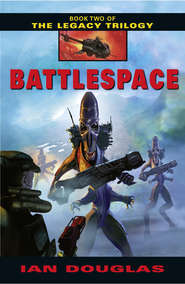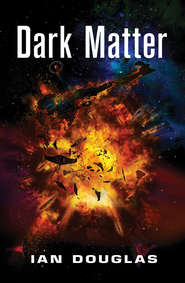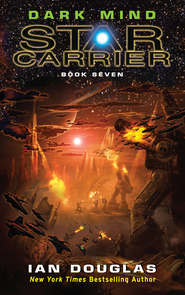По всем вопросам обращайтесь на: info@litportal.ru
(©) 2003-2024.
✖
Deep Time
Настройки чтения
Размер шрифта
Высота строк
Поля
“One moment, Admiral. We’re tracking …”
Gutierrez was an excellent officer—his exec when he’d been captain of the America. His promotion to admiral and her promotion to captain both had been provisional, forced on them by the needs of a service desperate for experienced line officers. Gray didn’t know how his evaluations were going to read next time, but he knew he was going to recommend her for permanent command of the America.
Of course, if that happened and Gray was not confirmed for a four-star admiral’s billet, he likely would end up flying a desk Earthside. The thought was not a pleasant one, but as always, the needs of the service came first.
Especially in the middle of a war.
“Admiral,” Gutierrez’s voice said in his head, “we’re not getting a clear picture. All of our data is coming in by way of VFA-96. We don’t have direct line of sight on them.”
A schematic drew itself in Gray’s head: the globe of Earth, the space elevator towers, the various orbital facilities. Quito Synchorbital reached almost 36,000 kilometers above Ecuador. North India was far around the curve of the Earth, almost exactly on the opposite side of the planet.
“What do we have?”
“The target is well cloaked. We’re tracking it by its mass ripple.”
Mass puckered surrounding space by its simple presence—an effect perceived as gravity. When that mass moved, the pucker dragged through the fabric of spacetime, creating a wake or ripple, a unique signature that could be read by the appropriate long-range scanners.
“Sir …” Gutierrez said after a moment’s hesitation, “these readings don’t make sense. We may be tracking …”
“What?”
“It might be an alien spacecraft, Admiral. Nonhuman technology.”
Human starships used gravitic singularity projectors to warp space ahead of them in rapid-fire pulses, in effect creating a moving gravity well that pulled the ship along after it with a smooth and uniform acceleration. Aerospace fighters, aircars, and other civilian and military fliers could operate within a planetary atmosphere, but using projectors powerful enough to move something as large as a starship near a planetary surface was a risky proposition, and technically extremely difficult. In fact, taking the gravitic projectors to the next higher level—using them to fold space around the ship in order to move faster than light—required a flat spacetime matrix, meaning that you needed to be well clear of the local star, to say nothing of nearby planets.
But possibly other technic and space-faring species had figured out how to slip in and out of local gravity wells without a problem.
“Well, that might explain how the hell they got it down to the surface in the first place,” Gray said finally.
“Elliot and the Hawes are dropping down to LEO, sir,” Gutierrez continued. “ETA … eight minutes.”
“And Intelligence is still reading those fighters as uncrewed?”
“The fighters are gone, sir. All destroyed. But they were under AI guidance, yes.”
“I want a closer look at the ship boosting out from Earth,” he said. “How soon can we clear the dock?”
“Almost immediately, Admiral. Five minutes.”
“Good. Do it. I’m on my way to the flag bridge.”
“We’ll warm up your seat for you, sir.”
Breaking free from the data feed, Gray stood up and walked into his sleeping compartment. Laurie Taggart sat up in bed, naked, and stretched. “Sandy? You coming to bed?”
“Nope … but I want you on the bridge ASAP.”
Commander Laurie Taggart was America’s chief weapons officer, and very, very good at what she did.
The sensuousness was gone in an instant. She slid out of bed. “What’s happening?”
“Check the feeds.” He took a small wad of uniform from a bulkhead dispenser and slapped it against his bare chest. The black programmed nanogel spread out from beneath his hand, rapidly covering his body from shoulders to hands and feet, complete with rank tabs at his throat. “We have someone boosting out of North India in a hell of a hurry, and we’re going to go after them.”
Taggart took a handful of shipboard utilities and let them cover her body. The microcircuitry grown inside them provided temperature control through quite a large range of environmental conditions, and with the addition of a helmet and shoulder-worn breather pack, could double as an emergency e-suit. As fashion statements, however, they left delightfully little to the imagination.
Which, Gray thought with mild surprise, was just fine. He was a Prim and a monagie still, a product of the Periphery and the edge-of-survival life in the half-drowned Manhat Ruins—the flooded canyons and crumbling towers that had been New York City until rising sea levels had drowned the place almost three and a half centuries ago. He’d been a Prim—a Primitive—by virtue of not having an electronic connection to the most basic services of modern life, and a monagie because he’d been partnered with one woman.
That woman’s stroke, though, had driven him to seek medical help within the USNA. He’d been expected to pay for those services, of course, and had done so by joining the USNA Navy.
He’d adjusted well enough, he thought. His wife, changed either by the stroke or by the rewiring of her brain at the medical center, had left him, and that was by far the most traumatic change to his life. He still missed her … but he’d found companionship and affection with people like Laurie, and had been making good progress in getting his life back together.
Sexual relationships between senior and junior officers were not encouraged, but were not outright forbidden, either. Laurie had been a more or less casual sex partner for a number of years, now, and so long as the relationship didn’t affect the performance of their respective duties, there was no problem. He was very careful never to show favoritism.
Gray was still a thoroughgoing monogie, though—sticking to one relationship at a time. He had the Periphery’s mistrust of group marriages and promiscuously open sex, even if he had to accept that most people within the USNA saw him as at least mildly perverted in that regard.
After a quarter century in the Navy, Trevor Gray found that he really didn’t give a fuck what people thought about his private life.
He swam onto the bridge just as Gutierrez gave the order to take America out of dock. While his quarters were inside one of the ship’s rotating hab modules—provided with half a G of spin gravity—the bridge was located on America’s spine aft of the huge shield cap and thus in microgravity.
“Cast off all magnetics and grapples,” Gutierrez’s voice was saying. “Maneuvering aft, one-tenth G …”
Gray felt the slight nudge of acceleration as he slid into his command seat and let it gently grab hold. Since ships could not use their gravitic drives anywhere close to orbital structures like Quito Synchorbital, not without causing serious structural damage, maneuvering in close was handled by a combination of tugs and plasma thrusters.
The projections on the flag bridge bulkhead showed the America as seen from one of those tugs. The warship was enormous, the largest humans had yet launched at over a kilometer in length overall, with a long and slender central spine extending aft from the massive umbrella shape of her shield cap. That forward tank, holding 27 billion liters of water, served both as reaction mass for the plasma thrusters and as shielding at relativistic velocities. From the tug’s perspective, several hundred meters off, the star carrier was sliding very slowly from deep shade into bright sunlight. Earth was mostly in darkness at the moment, but the synchorbital was far enough out that, at this time of the year, the sun peeked over the planet’s north pole as a literal midnight sun.
Not that the time of day or night or the amount of incident sunlight meant much to space-faring crews in any case. Slaving shipboard time to GMT minus five was purely for convenience.
Clear of the immense sprawl of the naval base—itself a tiny fraction of the vast complex stretching out to either side from the 36,000-kilometer mark of the Quito space elevator—the star carrier fired her thrusters, generating another solid thump of acceleration. And, slowly, she began to turn.
Lines of light and columns of flickering numbers painted themselves across the bulkhead image and inside Gray’s mind. America would have to skim close past Earth to get onto the alien’s tail; they might pick up a bit of additional boost from Earth’s gravity, though the effect would be minute compared to the power of the carrier’s gravitic drive. Mostly, the navigation department would have to allow for a slight course shift as America skimmed past the planet’s upper atmosphere.
Gray was naturally impatient to get under way, but let the debarkation proceed at its own pace. As commander of the entire carrier battlegroup, his proper sphere of interest was the big picture, not the handling of one ship. He linked in to the transmissions being relayed around the planet now from the destroyer Elliot.
The destroyer was similar in overall design to the carrier, but her shield cap was a slightly flattened cone, blunt, elongated, and deeply scoured by pitting and dust erosion despite the best efforts of her nanomatrix hull. Still, viewed from a battlespace drone pacing the Elliot as she accelerated out from Earth, she was an impressive sight.
Her quarry was already well over 6 million kilometers ahead of her, however. As soon as the mystery ship had gotten clear of Earth’s atmosphere, it had put on an astonishing burst of acceleration—so much that Gray was immediately convinced that his guess that the vessel was not a human-built ship was confirmed. The vessel was definitely from … someplace else. Gray would worry about the where later. For now, he had to focus on getting to the ship before it could get to wherever the hell it was going.
“CAG? This is Gray.”
“Yes, Admiral,” Captain Connie Fletcher replied in his mind. Her title, from “Commander Air Group,” derived from the time when aircraft carriers plied Earth’s oceans, and fighters needed an atmosphere to stay aloft. The CO of America’s contingent of fighters, recon snoops, and other small spacecraft was in the carrier’s Primary Flight Control center aft, “Prifly,” in the traditional terminology dating back to those same times.
“We need to stop Charlie One. America won’t be able to catch them in a stern chase, and I doubt that the Hawes or the Elliot will be able to either. It’s going to be up to the fighters.”
“We’ve been looking at intercept vectors, Admiral. It might be possible, but it’ll be tight. A hell of a lot depends on how soon Charlie can drop into metaspace.”
“Do what you can, Connie. Those … people may be Sh’daar, and they’ve been talking to the Confeds. We need to know what they’ve been talking about.”
“Will do, Admiral. The Black Demons are in the best position for an intercept. That will mean dropping some of our LEO coverage.”











